The HATEFUL 8 @ the SUN theatre |
Read more at in70mm.com The 70mm Newsletter |
| Written by: Rob (Bert) Murphy, Sun theatre, Melbourne, Australia | Date: 02.01.2016 |
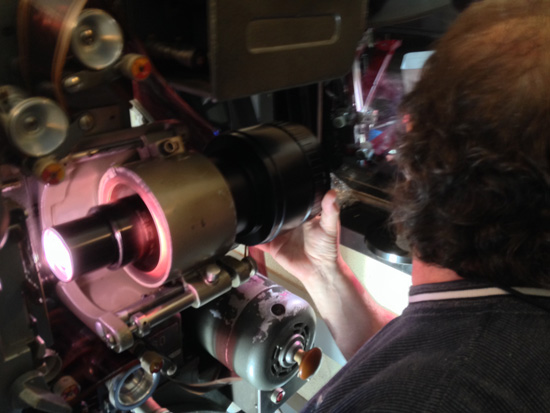 We
all really love to play with a Phillips DP70 but it soon became clear that a
Cinemeccanica Victoria 8 would be the safest most practical choice. We
all really love to play with a Phillips DP70 but it soon became clear that a
Cinemeccanica Victoria 8 would be the safest most practical choice.It was nearly six months ago when I first heard that Quentin Tarantino's new film would have a 70mm release option and that a few exhibitors in Australia were tooling up for it. I remember thinking, "a Tarantino film in 70... I can't wait to see it". Then I discovered it would not just be in 70 but Ultra Panavision 70. I was gob smacked. "This is going to be spectacular"! I knew the Astor (here in Melbourne) would have to be one of the screens but there was little information on the others and everything was rumour based, coming from the projectionist underground (as I like to think of it). But the more I heard and the more I read, the more excited I became. I'm fairly new to the family. Having only been a projectionist for 11 years and only catching the last 6 years of 35mm before digital (the independently owned Sun being the first complex in Australia to go fully DCI) but I'de always had a fascination and desire to run 70mm. I regularly enjoyed watching it at the Astor but only ever dreamed of running it myself. I can't believe it took me a whole week before I thought, "why couldn't we do this at the Sun"? |
More in 70mm reading: Quentin Tarantino's "The Hateful Eight" in Ultra Panavision 70 DP70s in Australia George Florence and 70mm at The Astor, Melbourne, Australia Cinerama At the Plaza The lost world of 70mm Theatres By Ian Hanson Camera 65 and the Metro Bourke Street Bigger than… Internet link: suntheatre.com.au youtube.com
|
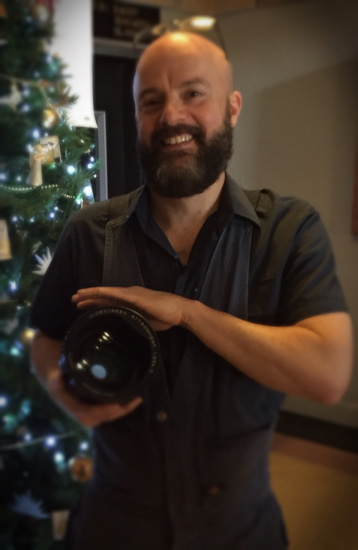 Three
days before Xmas, Santa came early. Bert Murphy with the anamorphic lens Three
days before Xmas, Santa came early. Bert Murphy with the anamorphic lensI took the idea to Michael Smith, Sun owner and film nut/adventurer who, like me, was immediately inspired; but we needed a lot more information before we could even consider this. Could we have a print even if we wanted one? Where could we find a lens? How would the sound be delivered? After initial enquires it seemed we were eligible and so then the avalanche of technical questions began. First off we considered running change over between two projectors, my personal preference for the simple selfish reason that I'd never done it before and wanted to. Eyes were rolled and the option quickly became academic due to the lack of space in our bio. Oh well. Next idea was a modified EPRAD mutt coming off a single projector. After some tape measure acrobatics, it seemed we could fit a platter instead but only if we could retrofit it for 70mm. Could we? Projector type. The Sun has a long tradition of German Bauer's so our first thought was a Bauer U3. We had previously run two of these, one on a hoist system. The other attraction here was these beasts could run 7000 ft spools both payout and take up at leg height. But as information dribbled through it became clear that the film was going to be to long for this to work. To be honest, none of us were particularly fond of the U3 and so the question became, what would we all really love to play with? A Phillips DP70, of course. We even found a few and looked them over but there was a lot of work to be done to both and then the question of where could we source parts quickly in an emergency burst the bubble. It soon became clear that a Cinemeccanica Victoria 8 would be the safest most practical choice and we had two sitting in a retired projectionist garage near by that were on offer for free. And so for me began a series of expeditions; rummaging through catacombs of old cinema's and back yard collections searching out artefacts from the glory days of 70mm projection. Sprockets, film gates, rollers and on a very good day a 70mm splicer were among the treasures I exhumed. |
|
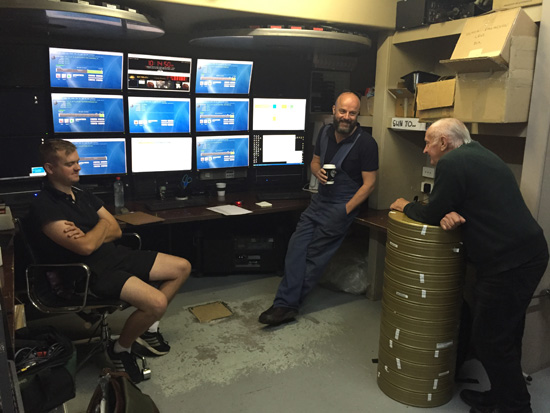 Three
generations of projectionist. (Left to right) Lewis Thorne, Bert Murphy,
Brian Davis Three
generations of projectionist. (Left to right) Lewis Thorne, Bert Murphy,
Brian DavisAll the while the weeks quickly rolled by as the projector junk piled up, waiting for the all important news that would launch us into action or shut us down completely; the availability and price off the Ultra Panavision anamorphic lens. The projector was still in its garage, we had a platter but no 70 running gear. Another three weeks passed. Argghh! Finally we couldn't wait any longer and everyone agree'd... we had to start the install and hope that the lens and DTS reader would fall into place. Getting the Projector into the bio was every bit the nightmare I had been imagining it to be. First, rolling it down the street on casters like an armoured shopping trolley got a few glances from passing traffic. Then into the foyer for the next challenge. It wouldn't fit in the lift. No problem; release the lamp house mount from the pedestal and carry it along behind. Next, the laborious five person job of ascending the cornered stairs up to the bio landing. This employed a see-sawing motion utilising blocks of wood and milk crates which finally got the beast into place next to the Christie digital, 90 minutes later. 'Phew'. |
|
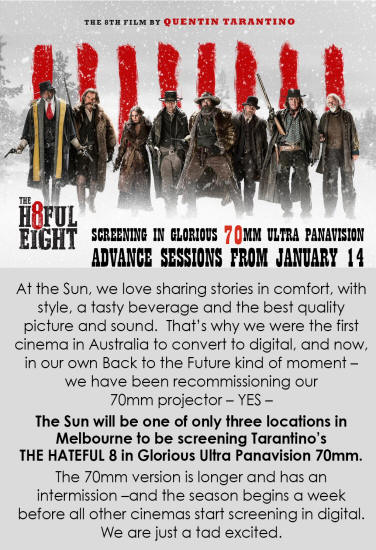 The
Sun's "Hateful Eight" splasher. Click to see enlargement The
Sun's "Hateful Eight" splasher. Click to see enlargementNow where to start. This projector hasn't run in twelve years. First the cleanup and stripping back to basics. We'd need the water cooling system reinstated as we wanted to run a 4K lamp in the strong lamp house we already had in the bio. Flushing gunk, dismantling and cleaning took about a week. Then new drive belts and inverter power supply for gentle starts took about another week. Ahh yes, the platter. We were exceedingly lucky in that some years before when disposing of the U3's someone had saved a curious set of elongated rollers that turned out to be 70's for the speco payout module. I remember the look on Simons face the morning I gave him a big hug when he put them down on the bench in front of me, "are these of any use"? We still needed to get the longer intake fingers made but having the rest of the module ready was a huge plus. I'd been quietly keeping the film enthusiast group CATHS (Cinema and Theatre Historical Society) apprised of our progress as many of their members are retired projectionists. I was hoping that they might turn up some useful bits and pieces so was very happy to secure a full 70mm print for the testing of the platter. 70mm junk just isn't out there. Even the pink prints are back yard treasures these days, each a relic with a story harkening back to the glory days of someone's time with 70mm. The collars for the platter also had to be super-sized. I had a friend at IMAX and had the idea that they might be able to help us after just recently decommissioning their 15/70 GT in favour of laser digital. They donated three collars to the cause. It was now late November and the dust had settled on just six screens in Australia who were kitting up. Three in Melbourne and three in Sydney. We were certainly the underdog, being a small independent. So the 6 a.m rises continued to fit in bio work before sessions. Still hoping, wondering if it was all going to come together and then just a week before Xmas... It did. Our lens and DTS reader arrived |
|
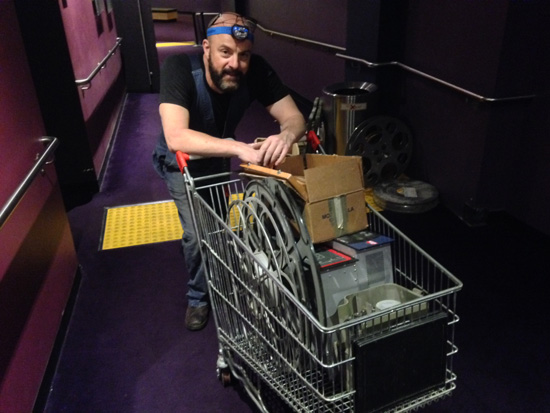 So
the question became, what would we all really love to play with? So
the question became, what would we all really love to play with?Then shortly after many wondrous mustard coloured cans with mystical words printed on them arrived. So it's now a few days before New Years and only two weeks before we're on screen. That beautiful piece of glass fits neatly (after some careful angle grinding of the lens mount on the projector) and our first test loops fit neatly from edge to edge of screen; bright and sharp. I honestly can't believe this is happening. Hell, I never thought I'd ever see anamorphic 70 projected let alone be the guy beside the projector. I'd always rejected the notion that digital was the replacement for film; replacement? Being digital makes it different, not necessarily superior. I love that every recorded media format has its own unique qualities that become a part of the story's that are captured on them. To say one is the replacement for another has always bewildered me. And with the breath taking grandeur of 70mm photography followed through to projection; there are still no rivals. I always thought that if the equipment could survive, in some way film would find its niche in the digital world and thanks to film makers like Quentin Tarantino, Christopher Nolan & Paul Thomas Anderson, that time may be here sooner rather than later. |
|
Sun Theater History
|
|
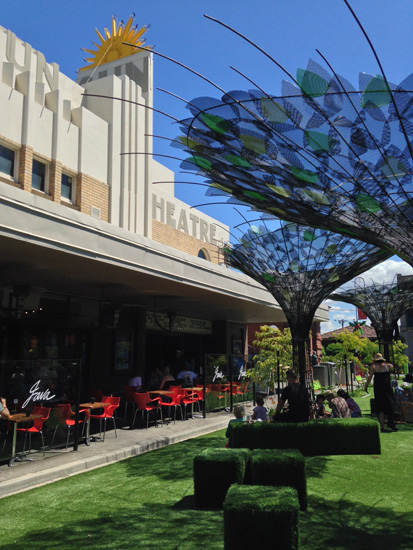 Sun
theatre, Melbourne, Australia Sun
theatre, Melbourne, AustraliaThe Sun originally opened in 1938 and was a single screen 1050 seat cinema - the most luxurious in the area. Most Saturday's were fully booked at the Sun; both a booking office and ticket counter were used to handle the large crowds. Today's SUN BOOKSHOP was the original candy bar. Imagine the buzz on a Saturday night which regularly sold out and 1050 patrons were in the foyer. Today we seat only several hundred over 8 boutique cinemas, but, we still think our foyer gets mighty busy. Unique to the cinema was the pram room where babies in their prams were placed and given a number, if your baby started crying, your number was flashed on the screen. During the 50's and 60's TV was the new novelty and the crowds dwindled. To satisfy the new population in Yarraville the SUN became a Greek cinema in the 60's. It was eventually closed by the Health department for unsanitary carpets! The SUN became derelict over the next twenty years until the current owners purchased it in 1995. It was in a sad state, a mecca for white ants and a roof so leaky, the plaster ceiling had caved in on the seats. Vagrants had been at it too, with squatters lighting fires to keep warm, graffiti and needles a plenty, while pilfering of much of the original art deco features had reduced her to little more than 4 brick walls. The new owners began one of Melbourne’s most popular film societies from 1998 to 2003 which encouraged them to go all out and bring the SUN back to glory. The large auditorium has been carefully and respectfully divided into 4 cinemas and another 4 cinemas have been added over several years to some land at the rear, the side and even above. Eight stunning cinemas, all detailed in an art deco style, many with original details are now open to the public and screening the latest new release films from Hollywood, Australia and art films from around the world. |
|
| Go: back - top - back issues - news index Updated 22-01-25 |
